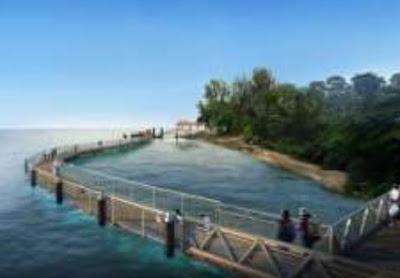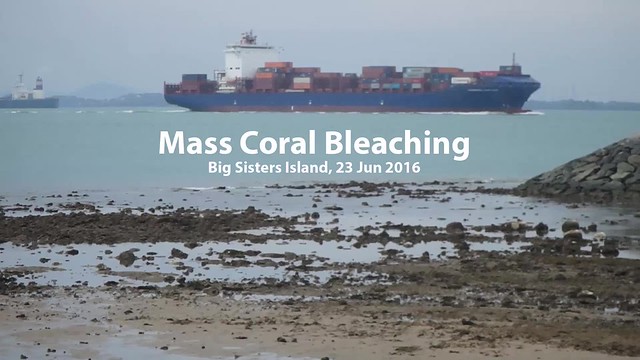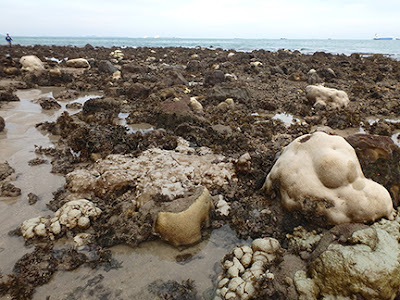 |
| A Tomato clown anemonefish in a bleaching Bubble-tip anemone. Photo by Carmen Lam during the June public walk. |
First, some happy news...
In May, stamps featuring the the Sisters' Islands legend were issued.
In May, NParks also unveiled plans for conservation work at the Marine Park. These include construction of a boardwalk, intertidal pools and a floating pontoon.
 |
| Image from NParks Press Release |
 |
| Image from NParks Press Release |
Sadly, the Marine Park also experienced mass coral bleaching
In recent articles, NParks explained how they hoped to deal with coral bleaching on Singapore's shores.
Mass coral bleaching in Singapore is not unexpected. From the NOAA's coral reef watch satellite monitoring,Singapore is in the yellow Watch zone. Where we should be prepared for mass coral bleaching.
June surveys by a team of volunteers found mass coral bleaching on both Small Sisters' Island and Big Sisters Island.
Here's a video of coral bleaching seen at Big Sisters Island.
What is coral bleaching?
Coral are colonies of tiny animals called polyps. Each polyp lives inside a little hard skeleton. The huge colony is made up of the skeletons of countless polyps. The polyps of all reef-building hard corals harbour microscopic, single-celled algae (called zooxanthellae).
The polyp provides the zooxanthellae with shelter and minerals. The zooxanthellae carry out photosynthesis inside the polyp and share the food produced with the polyp. Corals generally have white colour skeletons, which is believed to assist in photosynthensis by reflecting light onto the zooxanthellae.
When there is massive loss of zooxanthellae in a hard coral colony, the polyps become colourless and the underlying white skeleton shows through. Thus patches of the colony appear pale, white or 'bleached'. The polyps are still alive and the hard coral is not dead (yet). Without the food provided by the lost zooxanthellae, the polyps will be stressed and prone to diseases. Skeleton production and reproduction are also affected.
Once the cause of bleaching is removed, however, polyps may eventually regain zooxanthellae (which live freely in the water) and thus recover their health. But prolonged bleaching can kill corals and seriously damage large sections of a reef.
Factors believed to cause bleaching include: temperature fluctuations (too high or too low), excessive exposure to ultraviolet light, excessive sedimentation in the water, changes in salinity and disease. It is generally believed that bleaching is related to unusual prolonged temperature increases in the seawater.
Hard corals harbouring zooxanthellae live close to the upper limit of temperature tolerance. Thus a temperature increase of even 1-2 degrees centigrade can redult in bleaching. It is believed that global warming will lead to massive bleaching.
Other animals that harbour zooxanthellae, like sea anemones, can also bleach. Anemonefishes cannot survive without an anemone host. If the bleaching anemone succumbs and dies, so will the anemonefishes that live in it. Sadly, the volunteer guides found a dead anemonefish during one of the walks.
 |
| Photo by Ian Siah. |
 |
| Photo by Ian Siah. |
 |
| Photo by Adriane Lee. |
 |
| Photo by Richard Kuah. |
 |
| Photos by Adriane Lee. |
 |
| Photos by Li-May Chew. |
 |
| Photos by Richard Kuah. |
 |
| Photos by Cyrene Lin |
 |
| Photos by Dawn Koh. |
 |
| Photos by Lisa Lim. |
 |
| Photos by Ian Siah. |
Catch up with all the happenings at the Marine Park through the Sisters' Islands Marine Park facebook page. You can share your encounters, ideas and thoughts for the Marine Park here.

More about guided walks at the Sisters' Islands Marine Park on the NParks website.
More about what to expect at a guided walk.
Why should I visit with an experienced and trained guide? Why are places limited on a public walk? Which other shores are accessible to the public? and more in this wildsingapore page.









No comments:
Post a Comment